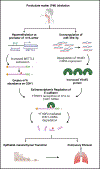Molecular mechanisms of environmental exposures and human disease
- PMID: 36717624
- PMCID: PMC10562207
- DOI: 10.1038/s41576-022-00569-3
Molecular mechanisms of environmental exposures and human disease
Abstract
A substantial proportion of disease risk for common complex disorders is attributable to environmental exposures and pollutants. An appreciation of how environmental pollutants act on our cells to produce deleterious health effects has led to advances in our understanding of the molecular mechanisms underlying the pathogenesis of chronic diseases, including cancer and cardiovascular, neurodegenerative and respiratory diseases. Here, we discuss emerging research on the interplay of environmental pollutants with the human genome and epigenome. We review evidence showing the environmental impact on gene expression through epigenetic modifications, including DNA methylation, histone modification and non-coding RNAs. We also highlight recent studies that evaluate recently discovered molecular processes through which the environment can exert its effects, including extracellular vesicles, the epitranscriptome and the mitochondrial genome. Finally, we discuss current challenges when studying the exposome - the cumulative measure of environmental influences over the lifespan - and its integration into future environmental health research.
© 2023. Springer Nature Limited.
Conflict of interest statement
Competing Interests
The authors declare no competing interests.
Figures






References
Publication types
MeSH terms
Substances
Grants and funding
LinkOut - more resources
Full Text Sources

